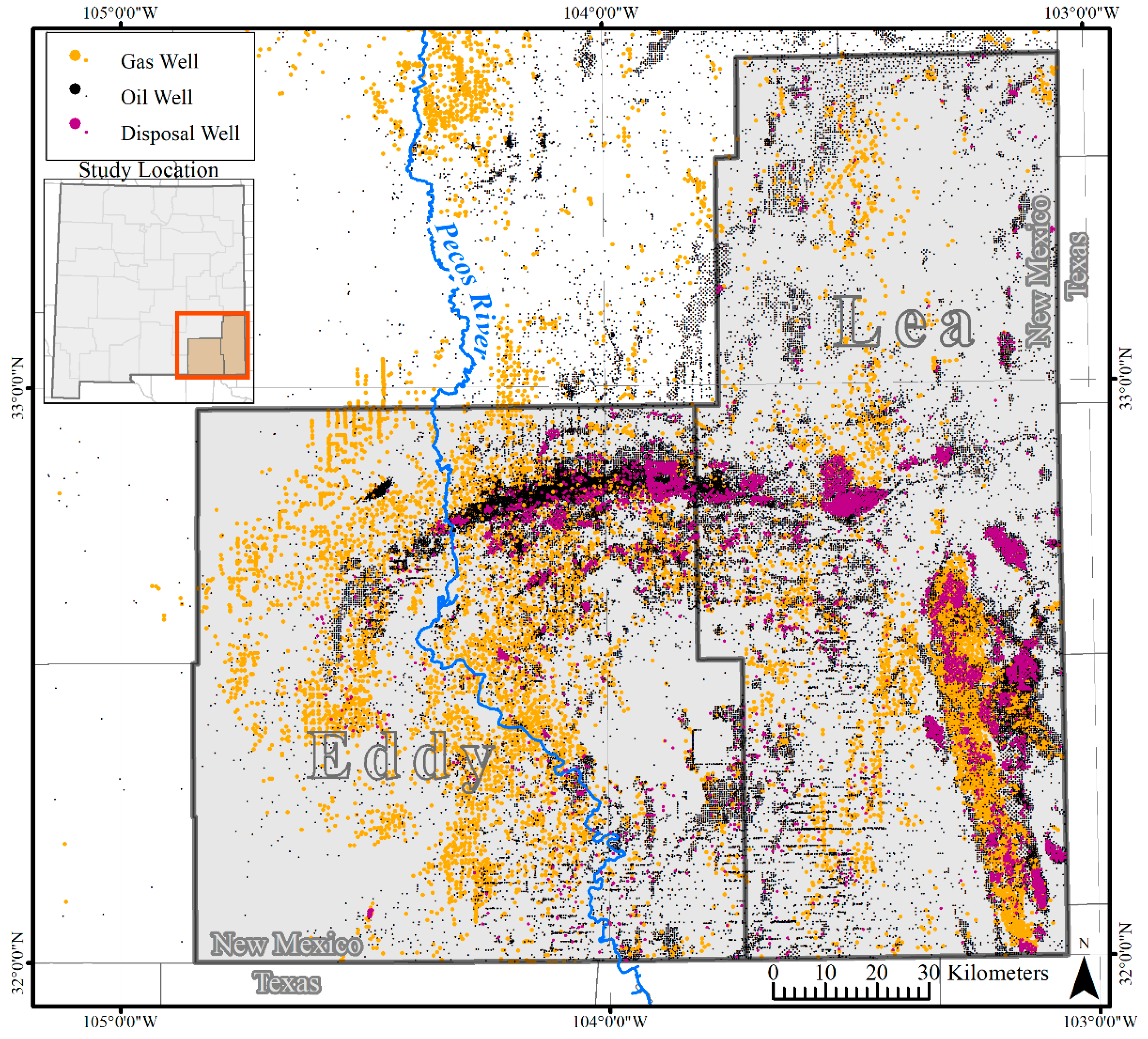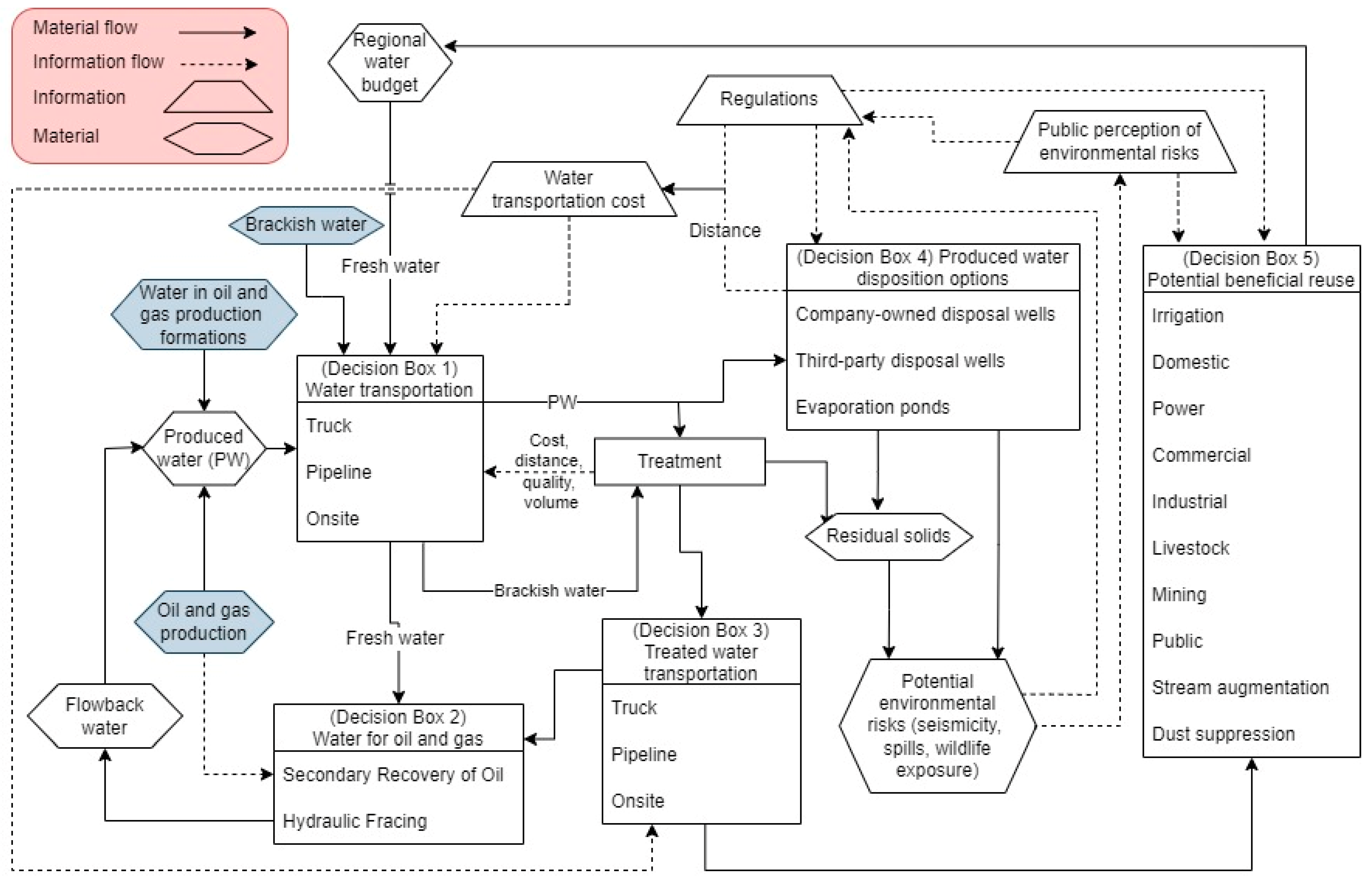Conceptual Framework for Modeling Dynamic Complexities in Produced Water Management
Abstract
:1. Introduction
2. Methods
2.1. Case Study Area
2.2. Synthetic Conceptual Model
2.2.1. Regional Water Budget—Material Flow
- P = precipitation
- Qin = water flow into the watershed
- ET = evapotranspiration
- ∆S = change in water storage
- Qout = water flow out of the watershed
- ∆HSDS = change in Human Storage and Distribution System over a given period of time
- ΔGWs = change in groundwater storage
- SWd = surface water diversions to human use
- Pr = precipitation directly into reservoirs
- SWr = surface water returns from human use
- PWt = treated produced water
- GWi = groundwater infiltration to groundwater from reservoirs and streams
- ETh = reservoir evaporation
2.2.2. Produced and Flowback Water—Material Flow
2.2.3. Water Transportation—Decision
2.2.4. Produced Water Disposal—Decision
2.2.5. Treatment—Decision
2.2.6. Regulations—Information Flow
2.2.7. Potential Beneficial Reuse—Material Flow
3. Discussion and Future Work
4. Conclusions
Author Contributions
Funding
Institutional Review Board Statement
Informed Consent Statement
Data Availability Statement
Acknowledgments
Conflicts of Interest
Appendix A
References
- Coonrod, C.L.; Yin, Y.B.; Hanna, T.; Atkinson, A.J.; Alvarez, P.J.; Tekavec, T.N.; Reynolds, M.A.; Wong, M.S. Fit-for-Purpose Treatment Goals for Produced Waters in Shale Oil and Gas Fields. Water Res. 2020, 173, 115467. [Google Scholar] [CrossRef] [PubMed]
- Mehler, W.T.; Nagel, A.; Flynn, S.; Zhang, Y.; Sun, C.; Martin, J.; Alessi, D.; Goss, G.G. Understanding the Effects of Hydraulic Fracturing Flowback and Produced Water (Fpw) to the Aquatic Invertebrate, Lumbriculus Variegatus under Various Exposure Regimes. Environ. Pollut. 2020, 259, 113889. [Google Scholar] [CrossRef] [PubMed]
- Scanlon, B.R.; Reedy, R.C.; Xu, P.; Engle, M.; Nicot, J.; Yoxtheimer, D.; Yang, Q.; Ikonnikova, S. Can We Beneficially Reuse Produced Water from Oil and Gas Extraction in the Us? Sci. Total Environ. 2020, 717, 137085. [Google Scholar] [CrossRef] [PubMed]
- Thomson, B.M.; Chermak, J.M. Analysis of the Relationship between Water, Oil & Gas in New Mexico: Investigation of Past and Future Trends; New Mexico Water Resources Research Institute, New Mexico State University: Las Cruces, NM, USA, 2021; Available online: https://nmwrri.nmsu.edu//wp-content/uploads/TR/tr390.pdf (accessed on 27 April 2022).
- Zhang, F.; Biederman, J.A.; Dannenberg, M.P.; Yan, D.; Reed, S.C.; Smith, W.K. Five Decades of Observed Daily Precipitation Reveal Longer and More Variable Drought Events across Much of the Western United States. Geophys. Res. Lett. 2021, 48, e2020GL092293. [Google Scholar] [CrossRef]
- Hedden, A. ‘The Time Is Now’: New Mexico Taking Action on Oil and Gas-Induced Earthquakes. Available online: https://www.currentargus.com/story/news/local/2021/11/26/new-mexico-taking-action-oil-and-gas-induced-earthquakes/8736667002/ (accessed on 26 November 2021).
- Scanlon, B.R.; Reedy, R.C.; Male, F.; Walsh, M. Water Issues Related to Transitioning from Conventional to Unconventional Oil Production in the Permian Basin. Environ. Sci. Technol. 2017, 51, 10903–10912. [Google Scholar] [CrossRef]
- Scanlon, B.R.; Ikonnikova, S.; Yang, Q.; Reedy, R.C. Will Water Issues Constrain Oil and Gas Production in the United States? Environ. Sci. Technol. 2020, 54, 3510–3519. [Google Scholar] [CrossRef]
- Langarudi, S.P.; Sabie, R.P.; Bahaddin, B.; Fernald, A.G. A Literature Review of Hybrid System Dynamics and Agent-Based Modeling in a Produced Water Management Context. Modelling 2021, 2, 224–239. [Google Scholar] [CrossRef]
- Beattie, K.S.; Gunter, D.; Bianchi, L.; Zamarripa-Perez, M.; Drouven, M.; Calderon, A.J. Pareto V1. 0.0. Computer Software. 20 September 2021. Available online: https://www.osti.gov//servlets/purl/1828132 (accessed on 27 April 2022). [CrossRef]
- Geza, M.; Ma, G.; Kim, H.; Cath, T.Y.; Xu, P. Idst: An Integrated Decision Support Tool for Treatment and Beneficial Use of Non-Traditional Water Supplies–Part I. Methodology. J. Water Process. Eng. 2018, 25, 236–246. [Google Scholar] [CrossRef]
- Ma, G.; Geza, M.; Cath, T.Y.; Drewes, J.E.; Xu, P. Idst: An Integrated Decision Support Tool for Treatment and Beneficial Use of Non-Traditional Water Supplies–Part II. Marcellus and Barnett Shale Case Studies. J. Water Process. Eng. 2018, 25, 258–268. [Google Scholar] [CrossRef]
- Graham, E.J.S.; Jakle, A.C.; Martin, F.D. Reuse of Oil and Gas Produced Water in South-Eastern New Mexico: Resource Assessment, Treatment Processes, and Policy. Water Int. 2015, 40, 809–823. [Google Scholar] [CrossRef]
- Baca, S.R.; Kupfer, A.; McLain, S. Analysis of the Relationship between Current Regulatory and Legal Frameworks and the “Produced Water Act”; New Mexico Water Resources Research Institute, New Mexico State University: Las Cruces, NM, USA, 2021; Available online: https://nmwrri.nmsu.edu/wp-content/uploads/TR/tr396.pdf (accessed on 27 April 2022).
- Ground Water Protection Council. Produced Water Report: Regulations, Current Practices, and Research Needs; Ground Water Protection Council: Oklahoma City, OK, USA, 2019; Available online: https://www.gwpc.org/uploads/documents/Research/Produced_Water_Full_Report_Digital_Use.pdf (accessed on 3 April 2022).
- Tidwell, V.; Gunda, T.; Caballero, M.; Xu, P.; Xu, X.; Bernknopf, R.; Broadbent, C.; Malczynski, L.A.; Jacobson, J. Produced Water-Economic, Socio, Environmental Simulation Model (Pw-Eseim) Model: Proof-of-Concept for Southeastern New Mexico; Sandia National Lab.(SNL-NM): Albuquerque, NM, USA, 2022. Available online: https://www.osti.gov/servlets/purl/1868149 (accessed on 1 June 2022).
- Jiang, W.; Xu, X.; Hall, R.; Zhang, Y.; Carroll, K.C.; Ramos, F.; Engle, M.A.; Lin, L.; Wang, H.; Sayer, M. Characterization of Produced Water and Surrounding Surface Water in the Permian Basin, the United States. J. Hazard. Mater. 2022, 430, 128409. [Google Scholar] [CrossRef]
- Jiang, W.; Pokharel, B.; Lin, L.; Cao, H.; Carroll, K.C.; Zhang, Y.; Galdeano, C.; Musale, D.A.; Ghurye, G.L.; Xu, P. Analysis and Prediction of Produced Water Quantity and Quality in the Permian Basin Using Machine Learning Techniques. Sci. Total Environ. 2021, 801, 149693. [Google Scholar] [CrossRef]
- Chaudhary, B.K.; Sabie, R.; Engle, M.A.; Xu, P.; Willman, S.; Carroll, K.C. Spatial Variability of Produced-Water Quality and Alternative-Source Water Analysis Applied to the Permian Basin, USA. Hydrogeol. J. 2019, 27, 2889–2905. [Google Scholar] [CrossRef]
- Schultz, R.; Skoumal, R.J.; Brudzinski, M.R.; Eaton, D.; Baptie, B.; Ellsworth, W. Hydraulic Fracturing-Induced Seismicity. Rev. Geophys. 2020, 58, e2019RG000695. [Google Scholar] [CrossRef]
- Sabie, R.P.; Pillsbury, L.; Xu, P. Spatiotemporal Analysis of Produced Water Demand for Fit-for-Purpose Reuse—a Permian Basin, New Mexico Case Study. Water 2022, 14, 1735. [Google Scholar] [CrossRef]
- Rawling, G.C.; Rinehart, A.J. Lifetime Projections for the High Plains Aquifer in East-Central New Mexico; New Mexico Bureau of Geology and Mineral Resources: Socorro, NM, USA, 2017; Available online: https://geoinfo.nmt.edu/publications/openfile/downloads/500-599/591/Report/OFR-591-High_Plains_Aquifer_lifetime_projection.pdf (accessed on 12 April 2022).
- Peterson, K.; Hanson, A.; Roach, J.; Randall, J.; Thomson, B. A Dynamic Statewide Water Budget for New Mexico: Phase Iii-Future Scenario Implementation; New Mexico Water Resources Research Institute, New Mexico State University: Las Cruces, NM, USA, 2019; Available online: https://nmwrri.nmsu.edu/wp-content/uploads/TR/tr380.pdf (accessed on 27 April 2022).
- Rubinstein, J.L.; Mahani, A.B. Myths and Facts on Wastewater Injection, Hydraulic Fracturing, Enhanced Oil Recovery, and Induced Seismicity. Seismol. Res. Lett. 2015, 86, 1060–1067. [Google Scholar] [CrossRef]
- Amoatey, P.; Izady, A.; Al-Maktoumi, A.; Chen, M.; Al-Harthy, I.; Al-Jabri, K.; Msagati, T.A.; Nkambule, T.T.; Baawain, M.S. A Critical Review of Environmental and Public Health Impacts from the Activities of Evaporation Ponds. Sci. Total Environ. 2021, 796, 149065. [Google Scholar] [CrossRef]
- United States Environmental Protection Agency. Review of State and Industry Spill Data: Characterization of Hydraulic Fracturing-Related Spills; United States Environmental Protection Agency: Chicago, IL, USA, 2015. Available online: https://www.epa.gov/sites/production/files/2015-05/documents/hf_spills_report_final_5-12-15_508_km_sb.pdf (accessed on 2 May 2022).
- Ramirez, P. Bird Mortality in Oil Field Wastewater Disposal Facilities. Environ. Manag. 2010, 46, 820–826. [Google Scholar] [CrossRef]
- Caldwell, J.A.; Williams, C.K.; Brittingham, M.C.; Maier, T.J. A Consideration of Wildlife in the Benefit-Costs of Hydraulic Fracturing: Expanding to an E3 Analysis. Sustainability 2022, 14, 4811. [Google Scholar] [CrossRef]
- Osipi, S.R.; Secchi, A.R.; Borges, C.P. Cost Assessment and Retro-Techno-Economic Analysis of Desalination Technologies in Onshore Produced Water Treatment. Desalination 2018, 430, 107–119. [Google Scholar] [CrossRef]
- Xu, P.; Ma, G.; Stoll, Z. Assessment of Treatment Technologies for Produced Water to Improve Water Supply Sustainability in Southeastern New Mexico; New Mexico Water Resources Research Institute, New Mexico State University: Las Cruces, NM, USA, 2016. [Google Scholar]
- Simate, G.S.; Ndlovu, S. Acid Mine Drainage: Challenges and Opportunities. J. Environ. Chem. Eng. 2014, 2, 1785–1803. [Google Scholar] [CrossRef]
- Mavukkandy, M.O.; Chabib, C.M.; Mustafa, I.; Ghaferi, A.A.; AlMarzooqi, F. Brine Management in Desalination Industry: From Waste to Resources Generation. Desalination 2019, 472, 114187. [Google Scholar] [CrossRef]



Publisher’s Note: MDPI stays neutral with regard to jurisdictional claims in published maps and institutional affiliations. |
© 2022 by the authors. Licensee MDPI, Basel, Switzerland. This article is an open access article distributed under the terms and conditions of the Creative Commons Attribution (CC BY) license (https://creativecommons.org/licenses/by/4.0/).
Share and Cite
Sabie, R.; Langarudi, S.P.; Perez, K.; Thomson, B.; Fernald, A. Conceptual Framework for Modeling Dynamic Complexities in Produced Water Management. Water 2022, 14, 2341. https://doi.org/10.3390/w14152341
Sabie R, Langarudi SP, Perez K, Thomson B, Fernald A. Conceptual Framework for Modeling Dynamic Complexities in Produced Water Management. Water. 2022; 14(15):2341. https://doi.org/10.3390/w14152341
Chicago/Turabian StyleSabie, Robert, Saeed P. Langarudi, Kevin Perez, Bruce Thomson, and Alexander Fernald. 2022. "Conceptual Framework for Modeling Dynamic Complexities in Produced Water Management" Water 14, no. 15: 2341. https://doi.org/10.3390/w14152341
APA StyleSabie, R., Langarudi, S. P., Perez, K., Thomson, B., & Fernald, A. (2022). Conceptual Framework for Modeling Dynamic Complexities in Produced Water Management. Water, 14(15), 2341. https://doi.org/10.3390/w14152341





